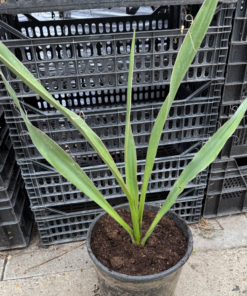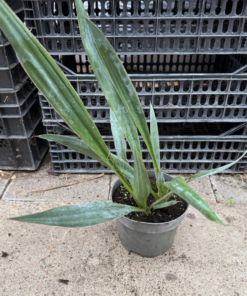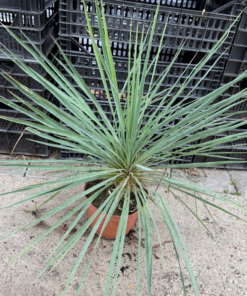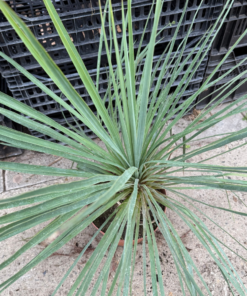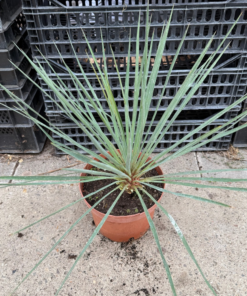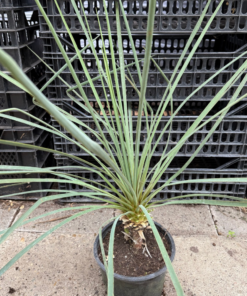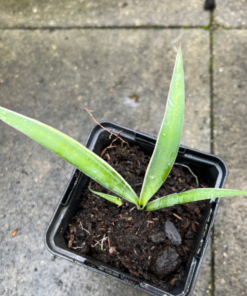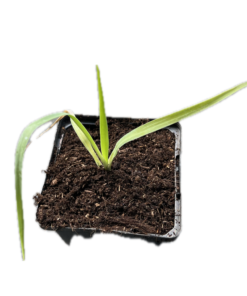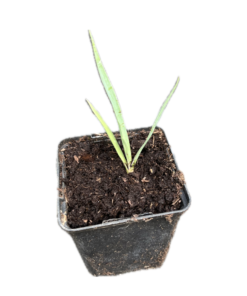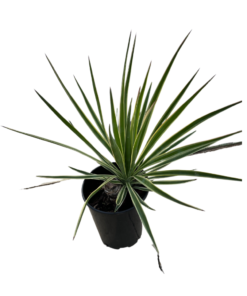Looking for special Yucca plants? Then you have come to the right place! We have self-produced palm species and crosses in our range. We have large and small yuccas. We offer exclusive Yucca species that are not often available on the market. This allows us to stand out from the competition. We have cultivated most palms with love for you! We deliver to your door so that you can start planting straight away!
Yucca's
€54,50
Yucca's
€38,15
Yucca's
€119,90
Yucca's
€92,65
Yucca's
€76,30
Yucca's
€10,89
Yucca's
€9,81
Yucca's
€54,50
Variegated
€294,30
Yucca's
€16,35
Yucca's
€15,26
Variegated
€54,50
General information about the Yucca plant:
We all know Yucca, which is also offered or sold as a desert plant or cactus. The most common Yucca species are Yucca filamentosa and Yucca rostrata. Yucca can withstand dry conditions and needs little water. In winter, when it rains heavily, the Yucca is protected by an umbrella over the plant against rain, which can freeze in the core. This causes the core to rot. This can lead to the death of the Yucca or require a long recovery period. A Yucca can sting very strongly, so beware if you have young children. There are two types of Yucca: a Yucca plant with a stem and a plant that has no stem and remains small. We know of about 50 different species of Yucca. The propagation of a Yucca species is only possible by means of seeds or tissue cultures. The Yucca plant is not toxic to humans or animals.
The growth of a Yucca :
Growth comes from the heart of the Yucca stem. A Yucca always grows straight towards the light. Yuccas always produce several leaves at a time, which unfold into a crown. In winter, if too much water penetrates the core of the growing point, this can cause problems such as stem rot. In the case of stem rot, new stems are pulled out of the heart of the Yucca and the new growing point is rotten. You can prevent this by protecting the Yucca growing point from moisture by hanging an umbrella over it. In most cases of spear rot, it takes several months before the Yucca is fully recovered. However, our experience also shows that some Yucca plants do not survive spear rot. Yucca plants have a particular shape compared to other trees and shrubs. A mature Yucca can be recognised by its long or short, single or clustered stems. Yucca trunks are often made up of layers of old leaves that have been cut off. In some species, people have modified the stem by cutting off the old leaves. This creates a sort of dessert look. The roots of a Yucca, especially in the beginning when the seed germinates, are a long taproot. This taproot gathers into several roots in the soil. In older Yuccas we see many roots that are deeply embedded in the soil. The Yucca consists of three parts: the roots, the stem and the leaves.
Watering a Yucca :
In general, Yuccas do not like a lot of water. Therefore, you should only water a Yucca plant if the soil becomes dry. In summer, Yucca likes a lot of water, but it is almost impossible to overwater it, so you should give it enough water and occasionally give it some plant food. In winter the Yucca is at rest. Make sure that the root ball is not wet to prevent rotting.
Yucca care:
The care of a Yucca is simple. Older leaves that turn brown at the base of the trunk can be cut off with a pair of sharp secateurs. It is normal for brown leaves to appear over time as the bush grows rapidly. Please note that if a Yucca is in a large pot, it may need to be repotted. You can see this when the roots push the shrub upwards and are full of strong white roots. It is recommended to plant and replant a shrub in spring. This gives the best chance of success.
The history of a yucca :
Yucca has been around for a very long time and was discovered as a fossil about 80 million years ago. In the past, 5000 years before Christ, people cultivated the yucca to achieve a majestic appearance.
The inflorescence of a yucca :
The yucca is both male and female. The male pollen is located around the large pistil. The large pistil is female. On this one, the Yucca plant catches the male pollen. Just as with people, we need male pollen for the pollination of the female flower. After a successful pollination, a few months later a large number of pods follow on the flower cluster how. In nature, yuccas use the wind as a means of pollination. Young yuccas do not flower during their first years, but after about 5 years the plant starts to flower. At the heart of the plant is a large flowering stem. Yucca often only flowers once a year in spring. Yucca produces pods from the flower clusters. When the pods are ripe, they open up and black seeds come out. A Yucca can produce up to 5000 seeds on a flower stalk.
What people think when they hear the word Yucca:
Most people, when they hear Yucca, think of a desert or a hot climate. Yucca grows in both hot and cold climates. Yucca is very tropical and gives a tropical feel to a holiday.
Crossing a Yucca:
We are always looking for new species of yucca. The crossing and breeding of Yucca plants gives us a new assortment of Yucca species every year. Each year our female flowers are used to pollinate another species of the Yucca family. In particular, the genes of Yucca linearifolia and Yucca faxoniana have become very interesting for us to crossbreed new hardy Yucca species. Thus, in time, we will be able to create our own favourite Yucca species with their specific characteristics. In the future we hope to cross more with Yucca faxoniana and Yucca queretaroensis. The crossing of Yucca species is also called hybrid yucca.





